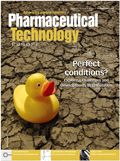Magnetically Controlling Pills For Better Drug Delivery
Many solid oral dosage forms do not dissolve at the correct place in the gastrointestinal tract for them to be absorbed into the bloodstream. Could magnets solve the problem?
Researchers at Brown University (RI, USA) have developed a magnetic system that can hold a pill in the correct place for optimal absorption. The technology has been safely tested in rats and could be used as a new treatment. Pharmaceutical Technology Europe spoke to Edith Mathiowitz, Professor of Medical Science in Brown’s Department of Molecular Pharmacology, Physiology and Biotechnology, to find out more.
How does the technology work?
Due to inter‑patient and intra‑patient variability in gastrointestinal (GI) transit time, pills do not always dissolve at the expected location, but our magnetic technology enables a pill to remain in the area of interest for a user‑defined duration.

Edith Mathiowitz. Credit: Mike Cohea/Brown UniversityThe magnetic pill is dosed orally, and involves the use of a gelatine capsule containing a tiny magnet and an external magnet that can precisely sense the force between it and the pill. When the pill reaches the desired region of drug delivery — based on gastrointestinal transit time and confirmed by fluoroscopy — an external magnet approaches the desired site of retention until a safe, maximum force is reached, as measured by a load cell. Once this force is reached, the external magnet moves away from the internal magnet until a minimum force is reached and then the cycle repeats for a user‑defined period of time. While the external magnet is cycling between force boundaries, the magnetic pill is retained safely and effectively. After the conclusion of the experiment, the magnetic pill is excreted.
As long as the pill does not dissolve too quickly, the added residence time in the desired location enables more effective dissolution. The pills can also be designed to overestimate the amount of time prior to dissolution, making the target far more achievable and reproducible provided that retention is reliable and safe, which were among our high priority design goals in creating our new system.
Why did you and the other researchers feel that improvements were needed in the area of gastrointestinal drug adsorption?
The number of approved and pipeline therapeutics exhibiting poor absorption or a narrow absorption window is increasing. We sought to create a system that would enable investigators to test where their compounds achieve the greatest absorption and to determine if prolonging retention for any amount of time would enable oral dosing of a therapeutic that would, otherwise, be unobtainable.
In particular, there is also a large unmet need of localised delivery for GI pathophysiologies, such as inflammatory bowel disease and esophageal cancer, which investigators have been working towards for many years. Our safe oral delivery system would have great therapeutic potential in this area because a number of therapeutics would benefit from prolonged localisation either at their site of action or their site of greatest absorption.
The system could also be used to investigate the absorption of new drugs in various locations to determine where they are best absorbed. This information could be extremely useful for designing an optimal drug delivery system for a new compound. In addition, the system could be beneficial for evaluating existing delivery systems for optimal operation.
Other research has been conducted with magnetic pills. How did you overcome the major challenge of developing a system safe to use in the body?
Our major safety innovation was to monitor the inter‑magnetic force experienced between the magnetic pill and the external magnet, and then to cycle between safe force boundaries. The cyclical application of force is meant to alleviate localised stress periodically, while still maintaining the pill for prolonged durations.
One of the major challenges of the work was defining a safe upper force limit that would still achieve sufficient inter-magnetic force to retain the magnetic pill, and then to design a feedback system that would cycle between the lower and upper force limits with a frequency that both minimised tissue damage and maximised retention efficacy. As such, the device and testing protocol underwent significant iteration on the way to achieving safe and effective magnetic pill retention.
How do you envision the system being used in a commercial world?
The research is still at an early preclinical stage. In a commercial world, we envision the system first being applied to severe pathophysiologies in which other therapeutic modalities are insufficient; namely cases of severe inflammatory bowel disease, or GI cancers in an in-patient setting.
Ultimately, if proven safe and effective in a clinical environment, we also envision use in an outpatient setting in which magnetic tracking rather than fluoroscopy is used to confirm the location of the magnetic pill.
The next challenges will be to incorporate drug into the system and then to transition into large animal studies. We will prioritise the oral delivery of therapeutics for disease states that currently require more invasive interventions, as well as therapeutics that otherwise exhibit such low oral absorption that they require alternative routes of administration. We would also like to work with investigators who are developing new chemical entities to investigate the site specificity of absorption or potential to increase bioavailability with prolonged retention.

Drug Solutions Podcast: A Closer Look at mRNA in Oncology and Vaccines
April 30th 2024In this episode fo the Drug Solutions Podcast, etherna’s vice-president of Technology and Innovation, Stefaan De Koker, discusses the merits and challenges of using mRNA as the foundation for therapeutics in oncology as well as for vaccines.
Pharmaceutical Tariffs Are Imminent: How Industry is Bracing for Impact
April 16th 2025On April 14, 2025, the Trump Administration launched a national security-driven investigation into pharmaceuticals, a move that will likely result in tariffs being placed on pharmaceutical drugs, ingredients, and other components that are imported from outside of the United States.